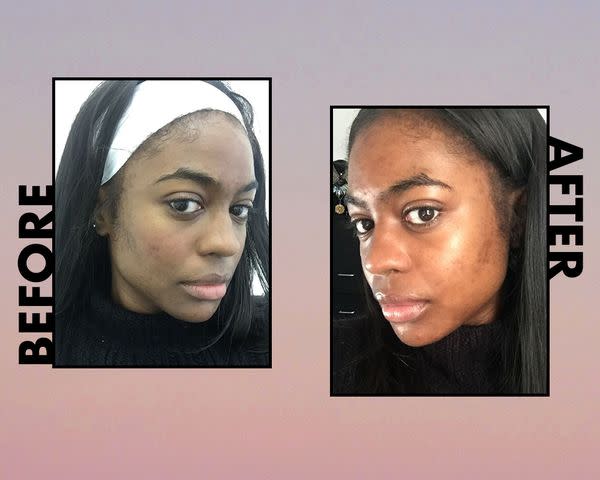What I Wish I Knew About Microneedling Before Trying It

Getty Images
Fact checked by Michelle RegaladoReviewed by Michele Farber, MD, FAAD
Before I get into everything there is to know about microneedling, let me just say that you can group me in the "down for anything" category when it comes to beauty. I'm typically open to trying any trend or treatment as long as experts say it's safe— this rings especially true when it comes to something that claims to improve one or more of my many skin concerns.
At the top of that list is my acne scars. The pesky marks popped up on my face when I was 23 years old, and I've been dealing with them ever since. I've tried every fading, brightening, and lightening treatment known to mankind. So, when I read one study that showed that almost 100 percent of microneedling participants reported a noticeable difference and 80 percent reported a vast improvement in the appearance of their acne scars after a treatment, I knew I had to try it out first-hand.
I immediately booked my appointment for an in-office microneedling treatment. I've had some time to reflect since I've had it done and have come up with more than a handful of things I wish I had known before booking that first appointment. If you're curious about microneedling, you're in luck. I asked four skin care experts to weigh in on the popular treatment and share everything there is to know about it, such as how in-office treatments compare to at-home microneedling devices. Now, if you decide to spend the time and money to get it done, you can feel completely prepared and confident in your choice.
Meet the Experts
Bruce Katz, MD, is a board-certified dermatologist operating out of Juva Skin & Laser Center in New York City.
Sejal Shah, MD, is a board-certified dermatologist at SmarterSkin Dermatology in New York City.
Josie Holmes is an esthetician at SKINNEY Medspa.
Gabe Lubin is the founder of Cartessa Aesthetics
What Is Microneedling?
"Microneedling is a cosmetic procedure that uses a device with very thin, sharp needle tips to make punctures on the skin," says New York City-based dermatologist, Bruce Katz. "The functionality behind microneedling is that once the body feels the small pricks, it works to heal those cuts, resulting in a refreshed look; the punctures are only surface-level, so the pain is minimal." This process works to rejuvenate your skin by boosting collagen production, which in turn reduces the appearance of wrinkles and fine lines and elevates the overall texture of your skin.
The particular microneedling treatment I underwent was done with a tool called the Vivace, a form of radiofrequency microneedling. "What excited me about the Vivace was, of course, the combination of radiofrequency and microneedling, but more so how precisely, cleanly, and deeply it could deliver both. Finally, you add in blue and red LED, and you have a trifecta of modalities to treat multiple skin concerns," explains Gabe Lubin, founder of Cartessa Aesthetics. "Physicians can select the exact depth best for each patient's skin type and condition and use robotic precision delivery to go as deep as 3.5 millimeters at 0.1-millimeter increments—no other device can." Blue light is helpful for those who suffer from acne, as the light and heat target bacteria that cause breakouts.
Benefits of Microneedling
Professional microneedling has a slew of immediate and long-term benefits, including:
Enhanced skin texture.
Reduced appearance of scars and hyperpigmentation.
Boosted collagen production.
Reduced appearance of fine lines and wrinkles.
"Microneedling by itself has only modest effects, like improvement in skin texture and smoothness," says Dr. Katz. "But when radiofrequency is added, microneedling can pack a bigger punch. Radiofrequency waves travel down the needles to heat the dermis, which can improve collagen production. Patients can see improvement in mild wrinkles, acne scars, and mild skin tightening when paired with radiofrequency. Microneedling in the dermatologist’s office is also done with sharper needles, which improves the results that patients see. You can also improve the results from microneedling by using a serum with the procedure; the serum will penetrate deeper in the skin for optimal results."
Dermatologist Sejal Shah, who performed my procedure, told me the biggest benefit of microneedling is its ability to radically enhance the texture of your skin. And that goes for more than just the face—microneedling can be used to improve pigmentation, lip lines, wrinkles, acne scars, hair loss, stretch marks, post-pregnancy stretch marks, and brighten the skin.
"Microneedling is a collagen-stimulating treatment great for general skin rejuvenation. It treats textural issues dealing with pores, acne scars, wrinkles, tightening sagging skin, and more," Dr. Shah explained to me while my numbing cream settled in. Then we begin the treatment.
How to Prepare Your Skin for Microneedling
If you're using any intense topical treatments, it's advised to discontinue use a few days before your microneedling treatment. Harsh products could aggravate the skin, so milder is the key. "In addition to having a cleansed and toned face, you should also avoid using retinol at least 48 hours prior and avoid direct sun exposure for about three days prior and three days following," notes Josie Holmes, an esthetician at SKINNEY Medspa. "I would also advise against using any aggressive acids within the week of the procedure."
You should arrive at your appointment with clean, dry skin (if not, the technician will wash your face so it's clean before the procedure). Next, you'll likely be slathered in numbing cream so that the pain won't feel as intense.
What to Expect from Microneedling
Does it hurt? It doesn't hurt per se, but it doesn't feel good After letting the numbing cream seep into my skin for a half-hour, having a bunch of needles continuously puncture my skin was honestly an easy process. In terms of pain, I experienced a tolerable treatment that lasted all of 20 minutes. To be real, it felt like five minutes, and by the end of it, I was fine. My forehead, hairline, and jawline areas were more sensitive than other areas. I barely felt the tool when it passed over my cheeks, which Dr. Shah surprisingly confirmed was the deepest level of depth.
After the microneedling, the procedure was followed up with a soothing serum and hydrating face mask that honestly felt like heaven. Ironically, even after the numbing cream wore off a couple of hours later, it didn't feel like I had just been poked hundreds of times. Contrary to how scary this sounds, I experienced no pain whatsoever.
"The great thing about this treatment is there's no significant downtime," says Dr. Shah. "Afterward, there's a little bit of redness and might be some areas of pinpoint bleeding, but really, it's a no-downtime kind of treatment, so most people leave here a little bit red. A couple of hours later, you're pretty much back to normal, and the next day, you can resume your normal skincare and normal activities."
Side Effects of Microneedling
Immediately after my face mask, my cheeks and the top of my forehead were slightly red. This is a normal side effect of the minimal bleeding that happens during the treatment. I was shook because the only time I experience redness is after a crazy workout. But this went away in an hour.
Another disclaimer to note: I have extremely sensitive skin, so this may not happen to you. But by day two, my skin felt raw and itchy. It wasn't unbearable, but it was definitely uncomfortable. To combat this, I slathered on Cortizone Anti-Itch Cream ($7) in the morning and before I went to bed. I also noticed tiny imprint marks (on my forehead especially) from the needles.
By day four, my itchiness had almost completely gone away. The tiny post-procedural marks also faded more and more each day. These are normal side effects and should clear up in a few days.
"There are no risks or downtime if microneedling is performed properly," notes Dr. Katz. "When microneedling is not performed properly, there are serious risks like infections, scarring, hyperpigmentation, and bruising."
At-Home vs. In-Office Microneedling
"Microneedling in the doctor's office can go a lot deeper than at-home devices and are thus more efficacious," says Dr. Katz. "At-home devices have minimal benefits compared to in-office microneedling. The needles are less sharp than the in-office microneedles, so there is less risk of injury to the user at home. That being said, at-home microneedling has more risks than in-office. Say you have a zit on your face that you rupture during the at-home treatment—then you are potentially rolling the p.acnes bacteria all over the rest of your face, which can lead to increased acne. I say leave the microneedling to a dermatologist who can make sure you get the best results."
Microneedling Aftercare

Maya Allen / Byrdie
Real talk, this lit-from-within glow is probably my favorite benefit of the procedure thus far. The photo on the left was taken right after I took off my sheet mask, while the photo on the right was taken the morning after my microneedling treatment. I was so impressed by the radiance of my skin. That cheekbone glow is not from highlighter, people.
I also was surprised by how soft my skin felt and how the appearance of my pores shrank significantly. I load up on hydrating oils every morning because of my inherently dry skin, and I'm addicted to how soft it leaves my skin feeling. I started waking up with cushion-like skin without all of the extra work and loved it so much that I decided to go makeup-free until my skin completely healed.
The Final Takeaway
Studies show that your topical products are more deeply penetrating after microneedling. This is so, so true. The week after my treatment, my hydrating moisturizer has felt so incredibly soothing on my skin—to the point that I look forward to cleansing my skin and applying it the second I walk into my apartment at the end of the day.
My pores feel so open and exposed—so I feel like my skin has been efficiently absorbing product (which is why I've decided to take it easy on the face makeup). I'm letting my skin soak up every second of this effect from my topical products.
If you're interested in microneedling, especially with the benefits of having it done in tandem with radiofrequency, it would be wise to speak with your board-certified dermatologist. They can assess your skin and decide whether or not it would be the right treatment for your particular concerns, whether that's acne marks, uneven tone, rough texture, or something else. And now you can make a more informed decision knowing that the pain and recovery isn't all that bad.
Up Next: Radiofrequency Microneedling Can Transform Scars and Fine Lines—Here's How
Read the original article on Byrdie.